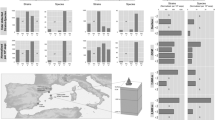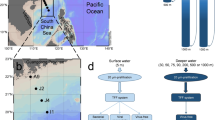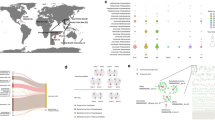Abstract
Owing to their abundance and diversity, it is generally perceived that viruses are important for structuring microbial communities and regulating biogeochemical cycles. The ecological impact of viruses on microbial food webs, however, may be influenced by evolutionary processes, including the ability of bacteria to evolve resistance to viruses and the theoretical prediction that this resistance should be accompanied by a fitness cost. We conducted experiments using phylogenetically distinct strains of marine Synechococcus (Cyanobacteria) to test for a cost of resistance (COR) to viral isolates collected from Mount Hope Bay, Rhode Island. In addition, we examined whether fitness costs (1) increased proportionally with ‘total resistance’, the number of viruses for which a strain had evolved resistance, or (2) were determined more by ‘compositional resistance’, the identity of the viruses to which it evolved resistance. A COR was only found in half of our experiments, which may be attributed to compensatory mutations or the inability to detect a small COR. When detected, the COR resulted in a ∼20% reduction in relative fitness compared to ancestral strains. The COR was unaffected by total resistance, suggesting a pleiotropic fitness response. Under competitive conditions, however, the COR was dependent on compositional resistance, suggesting that fitness costs were associated with the identity of a few particular viruses. Our study provides the first evidence for a COR in marine bacteria, and suggests that Synechococcus production may be influenced by the composition of co-occurring viruses.
Similar content being viewed by others
Log in or create a free account to read this content
Gain free access to this article, as well as selected content from this journal and more on nature.com
or
References
Baty F, Delignette-Muller ML . (2004). Estimating the bacterial lag time: which model, which precision? Int J Food Microbiol 91: 261–277.
Bergelson J, Purrington CB . (1996). Surveying patterns in the cost of resistance in plants. Am Nat 148: 536–558.
Bertilsson S, Berglund O, Karl DM, Chisholm SW . (2003). Elemental composition of marine Prochlorococcus and Synechococcus: implications for the ecological stoichiometry of the sea. Limnol Oceanogr 48: 1721–1731.
Bohannan BJM, Kerr B, Jessup CM, Hughes JB, Sandvik G . (2002). Trade-offs and coexistence in microbial microcosms. Anton Leeuw Int J G 81: 107–115.
Bohannan BJM, Lenski RE . (2000). Linking genetic change to community evolution: insights from studies of bacteria and bacteriophage. Ecol Lett 3: 362–377.
Bohannan BJM, Travisano M, Lenski RE . (1999). Epistatic interactions can lower the cost of resistance to multiple consumers. Evolution 53: 292–295.
Bouvier T, del Giorgio PA . (2007). Key role of selective viral-induced mortality in determining marine bacterial community composition. Environ Microbiol 9: 287–297.
Brahamsha B . (1996). A genetic manipulation system for oceanic cyanobacteria of the genus Synechococcus. Appl Environ Microbiol 62: 1747–1751.
Brockhurst MA, Buckling A, Rainey PB . (2005). The effect of a bacteriophage on diversification of the opportunistic bacterial pathogen, Pseudomonas aeruginosa. Proc R Soc Lond, B 272: 1385–1391.
Buckling A, Rainey PB . (2002). Antagonistic coevolution between a bacterium and a bacteriophage. Proc R Soc Lond, B 269: 931–936.
Chao L, Levin BR, Stewar FM . (1977). A complex community in a simple habitat: an experimental study with bacteria and phage. Ecology 58: 369–378.
Cottingham KL, Lennon JT, Brown BL . (2005). Knowing when to draw the line: designing more informative ecological experiments. Front Ecol Environ 3: 145–152.
de Roode JC, Pansini R, Cheesman SJ, Helinski MEH, Huijben S, Wargo AR et al. (2005). Virulence and competitive ability in genetically diverse malaria infections. Proc Natl Acad Sci USA 102: 7624–7628.
Feldgarden M, Riley MA . (1999). The phenotypic and fitness effects of colicln resistance in Escherichia coli K-12. Evolution 53: 1019–1027.
Fuhrman JA . (1999). Marine viruses and their biogeochemical and ecological effects. Nature 399: 541–548.
Fuhrman JA, Noble RT . (1995). Viruses and protists cause similar bacterial mortality in coastal seawater. Limnol Oceanogr 40: 1236–1242.
Gagneux S, Long CD, Small PM, Van T, Schoolnik GK, Bohannan BJM . (2006). The competitive cost of antibiotic resistance in Mycobacterium tuberculosis. Science 312: 1944–1946.
Gotelli NJ, Ellison AM . (2004). A Primer of Ecological Statistics. Sinauer: Sunderland, pp 510.
Harcombe WR, Bull JJ . (2005). Impact of phages on two-species bacterial communities. Appl Environ Microbiol 71: 5254–5259.
Inoue T, Matsuzaki S, Tanaka S . (1995). A 26-kDa outer-membrane protein, OmpK, common to Vibrio species is the receptor for a broad-host-range vibriophage, KVP40. FEMS Microbiol Lett 125: 101–105.
Jiang S, Fu W, Chu W, Fuhrman JA . (2003). The vertical distribution and diversity of marine bacteriophage at a station off Southern California. Microb Ecol 45: 399–410.
Kassen R, Rainey PB . (2004). The ecology and genetics of microbial diversity. Annu Rev Microbiol 58: 207–231.
Legendre P, Legendre L . (1998). Numerical Ecology. Elsevier: Amsterdam, pp 853.
Lenski RE . (1988a). Experimental studies of pleiotropy and epistasis in Escherichia coli 1. variation in competitive fitness among mutants resistant to virus-T4. Evolution 42: 425–432.
Lenski RE . (1988b). Experimental studies of pleiotropy and epistasis in Escherichia coli 2. compensation for maladaptive effects associated with resistance to virus-T4. Evolution 42: 433–440.
Lenski RE . (1998). Bacterial evolution and the cost of antibiotic resistance. Int Microbiol 1: 265–270.
Lenski RE, Levin BR . (1985). Constraints on the coevolution of bacteria and virulent phage – a model, some experiments, and predictions for natural communities. Am Nat 125: 585–602.
Lythgoe KA, Chao L . (2003). Mechanisms of coexistence of a bacteria and a bacteriophage in a spatially homogeneous environment. Ecol Lett 6: 326–334.
Mann NH . (2003). Phages of the marine cyanobacterial picophytoplankton. FEM Microbiol Rev 27: 17–34.
Marston MF, Sallee JL . (2003). Genetic diversity and temporal variation in the cyanophage community infecting marine Synechococcus species in Rhode Island's coastal waters. Appl Environ Microbiol 69: 4639–4647.
McDaniel L, Paul JH . (2005). Effect of nutrient addition and environmental factors on prophage induction in natural populations of marine Synechococcus species. Appl Environ Microbiol 71: 842–850.
Middelboe M, Hagstrom A, Blackburn N, Sinn B, Fischer U, Borch NH et al. (2001). Effects of bacteriophages on the population dynamics of four strains of pelagic marine bacteria. Microb Ecol 42: 395–406.
Mizoguchi K, Morita M, Fischer CR, Yoichi M, Tanji Y, Unno H . (2003). Coevolution of bacteriophage PP01 and Escherichia coli O157: H7 in continuous culture. Appl Environ Microbiol 69: 170–176.
Muhling M, Fuller NJ, Millard A, Somerfield PJ, Marie D, Wilson WH et al. (2005). Genetic diversity of marine Synechococcus and co-occurring cyanophage communities: evidence for viral control of phytoplankton. Environ Microbiol 7: 499–508.
Paul JH, Sullivan MB . (2005). Marine phage genomics: what have we learned? Curr Opin Biotechnol 16: 299–307.
Proctor LM, Fuhrman JA . (1990). Viral mortality of marine bacteria and cyanobacteria. Nature 343: 60–62.
Rocap G, Distel DL, Waterbury JB, Chisholm SW . (2002). Resolution of Prochlorococcus and Synechococcus ecotypes by using 16S-23S ribosomal DNA internal transcribed spacer sequences. Appl Environ Microbiol 68: 1180–1191.
Salathe M, Scherer A, Bonhoeffer S . (2005). Neutral drift and polymorphism in gene-for-gene systems. Ecol Lett 8: 925–932.
Sasaki A . (2000). Host-parasite coevolution in a multilocus gene-for-gene system. Proc R Soc Lond, B 267: 2183–2188.
Siemens DH, Lischke H, Maggiulli N, Schurch S, Roy BA . (2003). Cost of resistance and tolerance under competition: the defense-stress benefit hypothesis. Evol Ecol 17: 247–263.
Stomp M, Huisman J, de Jongh F, Veraart AJ, Gerla D, Rijkeboer M et al. (2004). Adaptive divergence in pigment composition promotes phytoplankton biodiversity. Nature 432: 104–107.
Sullivan MB, Waterbury JB, Chisholm SW . (2003). Cyanophages infecting the oceanic cyanobacterium Prochlorococcus. Nature 424: 1047–1051.
Suttle CA, Chan AM . (1994). Dynamics and distribution of cyanophages and their effect on marine Synechococcus spp. Appl Environ Microbiol 60: 3167–3174.
Szmelcman S, Hofnung M . (1975). Maltose transport in Escherichia coli K-12-involvement of bacteriophage-lambda receptor. J Bact 124: 112–118.
Thrall PH, Burdon JJ . (2000). Effect of resistance variation in a natural plant host-pathogen metapopulation on disease dynamics. Plant Pathol 49: 767–773.
Travisano M, Lenski RE . (1996). Long-term experimental evolution in Escherichia coli.4. Targets of selection and the specificity of adaptation. Genetics 143: 15–26.
Waterbury JB, Valois FW . (1993). Resistance to co-occurring phages enables marine Synechococcus communities to coexist with cyanophages abundant in seawater. Appl Environ Microbiol 59: 3393–3399.
Waterbury JB, Valois FW, Franks DG . (1986). Biological and ecological characterization of the marine unicellular cyanobacterium Synechococcus. Can Bull Fish Aquat Sci 214: 71–120.
Waterbury JB, Willey JM . (1988). Isolation and growth of marine planktonic cyanobacteria. Methods Enzymol 167: 100–105.
Weinbauer MG . (2004). Ecology of prokaryotic viruses. FEMS Microbiol Rev 28: 127–181.
Weinbauer MG, Rassoulzadegan F . (2004). Are viruses driving microbial diversification and diversity? Environ Microbiol 6: 1–11.
Wijngaarden PJ, van den Bosch F, Jeger MJ, Hoekstra RF . (2005). Adaptation to the cost of resistance: a model of compensation, recombination, and selection in a haploid organism. Proc R Soc Lond, B 272: 85–89.
Wilhelm SW, Suttle CA . (1999). Viruses and nutrient cycles in the sea – viruses play critical roles in the structure and function of aquatic food webs. Bioscience 49: 781–788.
Wilson WH, Carr NG, Mann NH . (1996). The effect of phosphate status on the kinetics of cyanophage infection in the oceanic cyanobacterium Synechococcus sp WH7803. J Phycol 32: 506–516.
Zwietering MH, Jongenburger I, Rombouts FM, Vantriet K . (1990). Modeling of the bacterial-growth curve. Appl Environ Microbiol 56: 1875–1881.
Acknowledgements
We thank C Jessup and AE Wilson for critical review of the paper. We acknowledge R Creton, J Nathanson, J Wong and the Leduc Bioimaging Facility at Brown University for assistance with confocal microscopy used for developing our filters sets for the competition experiments; M Tatar for plate reader access; J Casey preliminary lab work; A Michener for preliminary data analysis; K Mulder for statistical advice. This study was supported by the National Science Foundation (OCE-0315645 and OCE-0314523) and the Gordon and Betty Moore Foundation. This paper is dedicated to the memory of Alison Michener, an aspiring young scientist with a knack for enriching Synechococcus. Kellogg Biological Station contribution number 1420.
Author information
Authors and Affiliations
Corresponding author
Rights and permissions
About this article
Cite this article
Lennon, J., Khatana, S., Marston, M. et al. Is there a cost of virus resistance in marine cyanobacteria?. ISME J 1, 300–312 (2007). https://doi.org/10.1038/ismej.2007.37
Received:
Revised:
Accepted:
Published:
Issue date:
DOI: https://doi.org/10.1038/ismej.2007.37
Keywords
This article is cited by
-
Evolution of a minimal cell
Nature (2023)
-
Bacteria-phage coevolution with a seed bank
The ISME Journal (2023)
-
Viruses affect picocyanobacterial abundance and biogeography in the North Pacific Ocean
Nature Microbiology (2022)
-
In silico, in vitro and in vivo characterization of host-associated Latilactobacillus curvatus strains for potential probiotic applications in farmed Atlantic salmon (Salmo salar)
Scientific Reports (2022)
-
Resistance of Dickeya solani strain IPO 2222 to lytic bacteriophage ΦD5 results in fitness tradeoffs for the bacterium during infection
Scientific Reports (2022)



